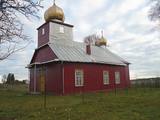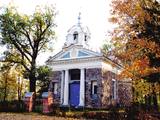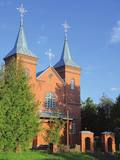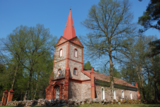| Нo | Название | Описание |
|---|---|---|
|
Celta 1933. g. vietējai brāļu draudzei. Baznīcā atrodas glezna “Kristus” (1850. g.) un Liepājas meistara Jēkaba Jauģieša 1920. g. darinātās ērģeles. Mūsdienās dievnamu izmanto Bārtas draudze. Pie baznīcas novietots akmens apkaimes represētajiem iedzīvotājiem. |
||
|
Atrodas Tirgoņu un Zāļu ielas krustojumā (Zāļu ielā 12). Interesanta ar faktu, ka šī ir vienīgā padomju laikā uzbūvētā (1948. g., pēc citiem avotiem – šajā gadā atjaunota) Latvijas baznīca. |
||
|
Eine der schönsten Landkirchen Estlands, wurde ursprünglich als Zufluchtsort verwendet. Wurde im Stil der Frühgotik gebaut. Die Wandmalerei aus dem Jahr 1330. |
||
|
Atrodas skaistā vietā – Elernes loka ziemeļdaļā, Daugavas senielejas malā. Mūsdienās redzamais dievnams celts no tēstiem laukakmeņiem iepriekšējo vietā laikā no 1934. - 1961. gadam. Pēc baznīcas uzcelšanas padomju vara tajā izvietoja klubu, tādēļ draudze baznīcu atguva tikai 1989. gadā. Šīs vietas agrākais nosaukums – Naujene (Novene) ir lietuviešu cilmes. Savukārt, Juzefovas vārds cēlies no vietējā muižnieka Juzefa (Jezupa) Šadurska. |
||
|
Gebaut am Ende des 13. Jh. als eine dreischiffige Basilika im romanischen Stil mit gotischen Elementen. 1853 wurde der 65 m hohe Turm aufgebaut (Aussichtsplatz). In der Kirche befinden sich die Grabsteine der livonischen Bischöfe, Kanzel (1748), Altar aus Eichenholz (1858), Altarbild (1862), Buntglasfenster und eine der besten Orgeln Lettlands (1907). |
||
|
Первая церковь здесь появилась в начале 18 столетия. Затем - вторая и третья (1847 - 1848), наблюдаемая сейчас. Храм пострадал и во время Первой мировой войны, и в советское время, когда с 1969 по 1993 год здесь размещался цех по производству ватина. Сейчас здание (в девяностых годах - в очень печальном состоянии) понемногу возвращает свой облик. Следует добавить, что в период с 1826 по 1856 год в храме пономарем и органистом работал латышский поэт и переводчик Ансис Ливенталс (1803 – 1878 гг.). Его могила с памятником находится рядом с церковью. Там же находятся кладбища русских и немецких солдат, павших во время Первой мировой войны, и надгробный памятник священника и писателя Якоба Флорентина Лундберга (1782 - 1857). |
||
|
Одна из самых красивых деревянных церквей Южной Латгалии. Построенный из бревен и обшитый досками храм строился в период с 1750 по 1751 гг. Сохранился алтарь работы XVIII века (резьба по дереву, барокко) и проспект органа, а также более 30 предметов, имеющих художественную ценность. Во дворе церкви в XIX веке построена колокольня. В направлении озера Рушонс построен деревянный пасторат. |
||
|
Моленная Нотренской старообрядческой общины. Построена
в 1928 – 1931гг. вместо старой, которая была возведена в 1853
году.
|
||
|
Located in the
|
||
|
From the tower of St Simon’s Lutheran Church, you can see the central part of Valmiera and the banks of the Gauja River. During clear weather, you can see Zilaiskalns Hill. The church contains some cultural and historical treasures, as well as one of Latvia’s most resonant pipe organs.
|
||
|
Līdz 18. gs. šajā vietā bija koka baznīca, kamēr 1798. g. uzcēla mūra baznīcu, kas cieta 1. pasaules karā, bet 2. pasaules kara laikā to uzspridzināja. Tikai pusgadsimtu vēlāk - 1991. gadā tika uzsākti atjaunošanas darbi, kas joprojām turpinās. Tagad redzamais dievnams ir iepriekšējā līdzinieks. |
||
|
На западном берегу озера Цирма возвышается построенная из валунов в 1830 г. церковь. Известность ей принесла картина с изображением Девы Марии, которой приписываются чудотворные способности. Поэтому это - популярная конечная цель паломников. |
||
|
Илзескалнская-Кульневская православная церковь
построена в 1832 году владельцем усадьбы Илзенбергс (Илзес-
калнс) Михаилом Кульневым, братом Якова Кульнева. Церковь
представляет собой прямоугольное здание с полукруглыми выступами. Здесь похоронены члены
семьи Кульневых. Место захоронения – уникальный объект посещения, что является редким среди
православных церквей Латвии.
|
||
|
Столеровский Римско-католический костёл Пресвятой Троицы.
В 1999 году под руководством декана Бутанса вместо сгоревшей была
построена новая церковь из красного кирпича. Сейчас – новейшая церковь
в Резекненском крае. Из часовни Розенмуйжи в церковь передана картина
Девы Марии.
|
||
|
Daugavpils – Krāslavas (A 6) ceļa malā redzamais dievnams uzcelts ar Plāteru dzimtas pārstāvju – Vaclava un Kazimira Plātera atbalstu 1811. gadā. Dievnamu ieskauj metālkaluma un no ķieģeļiem mūrēts žogs, kā arī divi zvanu torņi. Labās puses zvanu tornī karājas vecs zvans. No baznīcas iekārtas ir jāpiemin galvenais altāris, ko rotā Dievmātes skulptūra, trīs biktskrēsli, četras evaņģēlistu sienas freskas un Lurdas Dievmātes glezna. Ikdienā apskatāma no ārpuses. |
||
|
Находится на северо-восточном берегу Малого Субатского озера. Храм построен в 1685 – 1686 гг. в византийском стиле по распоряжению владельца господской усадьбы «Проде» Х. Ф. Остена - Закена. Это единственная церковь Латвии, архитектура которой напоминает характерные для конца 17 века идеальные формы храмов протестантов. Интерес представляют размещенные в углах здания маленькие башенки. Внутри храма находится богато орнаментированный и украшенный резьбой по дереву скульптурный ансамбль, в т.ч. - алтарь 17 века, кафедра и исповедальня, а также художественные работы 17 - 18 веков и отлитый в 1682 году колокол. Следует упомянуть, что часть церковного интерьера создали ремесленники Стелмужской школы скульпторов по дереву. |
||
|
Находится в западной части Виесите, со стороны ул. Калькю на т.н. холме Валес (оставленный ледником оз). В качестве интересного факта стоит упомянуть то, что в 1919 году в этом месте защитники Виесите нанесли поражение армии Бермонта. Закладка камня церкви состоялась 15 августа 1937 года (в День памяти героев), освящение - в 1939 году, а восстановление - в 1994 году. Финансовую поддержку в строительстве храма оказывал профессор Пауль Страдиньш. В храме находится алтарная икона Л. Цауне. К востоку от церкви, у подножья холма Валес установлен памятник П. Страдиньшу. |
||
|
Здание церкви было построено в 1835 году. Его гордостью является орган, который в 1854 году был построен Карлом Битнером. Проводится восстановление поместья приходского священника. Прокат лодок. |
||
|
Atrodas t.s. Baznīcu kalnā – 18. novembra ielā 66. Apjoma ziņā – lielākais Daugavpils luterāņu dievnams, kuru cēla laikā no 1891. - 1893. g. neogotiskā stilā no sarkanajiem ķieģeļiem (arhitekts Vilhelms Neimanis). 1941. g. baznīcā izcēlās ugunsgrēks un gāja bojā lielākā daļa no tās sākotnējās iekārtas. Turpmāko divu gadu laikā baznīcu daļēji atjaunoja, taču vēlāk tajā izveidoja noliktavu u.c. baznīcai „nepiederīgas” iestādes. 1985. g. ēka vēlreiz cieta ugunsgrēkā. Pagājušā gadsimta deviņdesmito gadu sākumā uzsāka baznīcas atjaunošanas darbus, uzstādīja solus un altāri, kas ir Ogres Amatniecības vidusskolas audzēkņu darinājums. |
||
|
Die kleinste und eine der reichtesten Kirchen Nordeuropas im Sinne der Zierelemente. Seit dem Bau im 14. Jh ist äußerlich kaum verändert worden. |
||





